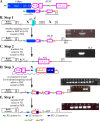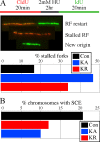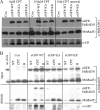RAD51 mutants cause replication defects and chromosomal instability
- PMID: 22778135
- PMCID: PMC3430192
- DOI: 10.1128/MCB.00406-12
RAD51 mutants cause replication defects and chromosomal instability
Abstract
RAD51 is important for restarting stalled replication forks and for repairing DNA double-strand breaks (DSBs) through a pathway called homology-directed repair (HDR). However, analysis of the consequences of specific RAD51 mutants has been difficult since they are toxic. Here we report on the dominant effects of two human RAD51 mutants defective for ATP binding (K133A) or ATP hydrolysis (K133R) expressed in mouse embryonic stem (ES) cells that also expressed normal mouse RAD51 from the other chromosome. These cells were defective for restarting stalled replication forks and repairing breaks. They were also hypersensitive to camptothecin, a genotoxin that generates breaks specifically at the replication fork. In addition, these cells exhibited a wide range of structural chromosomal changes that included multiple breakpoints within the same chromosome. Thus, ATP binding and hydrolysis are essential for chromosomal maintenance. Fusion of RAD51 to a fluorescent tag (enhanced green fluorescent protein [eGFP]) allowed visualization of these proteins at sites of replication and repair. We found very low levels of mutant protein present at these sites compared to normal protein, suggesting that low levels of mutant protein were sufficient for disruption of RAD51 activity and generation of chromosomal rearrangements.
Figures









Similar articles
-
Deletion of BRCA2 exon 27 causes defects in response to both stalled and collapsed replication forks.Mutat Res. 2014 Aug-Sep;766-767:66-72. doi: 10.1016/j.mrfmmm.2014.06.003. Epub 2014 Jun 22. Mutat Res. 2014. PMID: 25847274
-
Deletion of BRCA2 exon 27 causes defects in response to both stalled and collapsed replication forks.Mutat Res. 2014 Aug-Sep;766-767:66-72. doi: 10.1016/j.mrfmmm.2014.06.003. Epub 2014 Jun 22. Mutat Res. 2014. PMID: 25773776 Free PMC article.
-
Two replication fork maintenance pathways fuse inverted repeats to rearrange chromosomes.Nature. 2013 Sep 26;501(7468):569-72. doi: 10.1038/nature12500. Epub 2013 Sep 8. Nature. 2013. PMID: 24013173 Free PMC article.
-
Moonlighting at replication forks - a new life for homologous recombination proteins BRCA1, BRCA2 and RAD51.FEBS Lett. 2017 Apr;591(8):1083-1100. doi: 10.1002/1873-3468.12556. Epub 2017 Jan 30. FEBS Lett. 2017. PMID: 28079255 Review.
-
Wrestling off RAD51: a novel role for RecQ helicases.Bioessays. 2008 Apr;30(4):291-5. doi: 10.1002/bies.20735. Bioessays. 2008. PMID: 18348153 Review.
Cited by
-
The Regulation of Homologous Recombination by Helicases.Genes (Basel). 2020 May 1;11(5):498. doi: 10.3390/genes11050498. Genes (Basel). 2020. PMID: 32369918 Free PMC article. Review.
-
Sex or no sex: evolutionary adaptation occurs regardless.Bioessays. 2014 Apr;36(4):335-45. doi: 10.1002/bies.201300155. Epub 2014 Feb 13. Bioessays. 2014. PMID: 24531982 Free PMC article.
-
Human RAD51 rapidly forms intrinsically dynamic nucleoprotein filaments modulated by nucleotide binding state.Nucleic Acids Res. 2018 May 4;46(8):3967-3980. doi: 10.1093/nar/gky111. Nucleic Acids Res. 2018. PMID: 29481689 Free PMC article.
-
Human Rad51 promotes mitochondrial DNA synthesis under conditions of increased replication stress.Mitochondrion. 2013 Jul;13(4):350-6. doi: 10.1016/j.mito.2013.04.004. Epub 2013 Apr 13. Mitochondrion. 2013. PMID: 23591384 Free PMC article.
-
Rad51 regulates cell cycle progression by preserving G2/M transition in mouse embryonic stem cells.Stem Cells Dev. 2014 Nov 15;23(22):2700-11. doi: 10.1089/scd.2014.0129. Epub 2014 Aug 18. Stem Cells Dev. 2014. PMID: 24991985 Free PMC article.
References
-
- Adra CN, Boer PH, McBurney MW. 1987. Cloning and expression of the mouse pgk-1 gene and the nucleotide sequence of its promoter. Gene 60:65–74 - PubMed
-
- Araki K, Okada Y, Araki M, Yamamura K. 2010. Comparative analysis of right element mutant lox sites on recombination efficiency in embryonic stem cells. BMC Biotechnol. 10:29 doi:10.1186/1472-6750-10-29 - DOI - PMC - PubMed
-
- Bailey JA, Eichler EE. 2006. Primate segmental duplications: crucibles of evolution, diversity and disease. Nat. Rev. Genet. 7:552–564 - PubMed
Publication types
MeSH terms
Substances
Grants and funding
LinkOut - more resources
Full Text Sources
Other Literature Sources
Molecular Biology Databases
Research Materials
